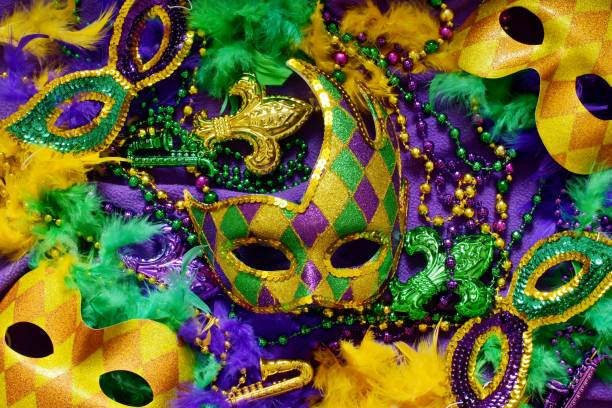
Mardi Gras w USA
Mardi Gras, USA
Mardi Gras is a religious and traditional festival in the USA. People celebrate this festival with events of the carnival on or after the Christian feast of the Epiphany. It is a celebration of eating rich food to full belly before sacrificing it for the period of Lent until the Easter Sunday arrives. This tradition is called Mardi Gras and came from France to North America. All over the USA there are multiple celebrations with huge Carnivals and food fests.
The Origins of Mardi Gras
Mardi Gras’ origins dates back to ancient pagan festivals and medieval European traditions of Saturnalia and Lupercalia, celebrations held in anticipation of spring. Once Christianity arrived to Europe, these festivals became religious holidays. Mardi Gras became the 40-day period of fasting before Easter.
Where does the name Mardi Gras come from?
The celebration was passionately adopted by French Catholics. The name “Mardi Gras,” which translates to “Fat Tuesday,” was chosen since the last day of the festival season was celebrated on the Tuesday preceding Ash Wednesday.
Beginnings of Mardi Gras in the US
Mardi Gras was first celebrated in what is now the United States on March 2, 1699. The holiday was established by French-Canadian explorer Jean Baptiste Le Moyne Sieur de Bienville when he departed France to plant a colony at the mouth of the Mississippi River. Sixty miles south of New Orleans, Jean Baptiste realized it was the eve of the holiday, prompting him to name the land “Pointe du Mardi Gras.” Three years later, in 1702, Jean Baptiste also established the settlement of Fort Louise de la Louisiane, also called Fort Louis de la Mobile. This settlement would later become known as Mobile, Louisiana, and would be the site of the first Mardi Gras celebration in the United States. The connection between Mardi Gras and Louisiana explains why the holiday is the most commonly associated with New Orleans.
Main Mardi Gras venues
During Mardi Gras, we can expect over a million of visitors. The celebration features brass bands, parades, king cakes, and beaded necklaces, with day-long festivities with food, music, and drinks. There are many events all over the city, but the more intense celebrations are on Bourbon Street.
Masks
In the early days of Mardi Gras in New Orleans, participants wore masks to escape social constraints and allow themselves to be free to mingle with any person they chose. Many krewes wore masks to keep their identities secret. Today, any person who rides on a float during a Mardi Gras parade, other than celebrities or krewe royalty, is required by law to disguise his or her face. Some krewes wear masks, while others choose to paint their faces.
Colors
The official colors of New Orleans Mardi Gras are purple, green and gold. These colours were chosen in 1872 in part to honor the Russian Grand Duke Alexei Alexandrovich Romanov, who visited New Orleans during that carnival season. People of New Orleans display these colors, which represent justice (purple), faith (green) and power (gold), on Mardi Gras.
The Origin of the King Cake
A signature Mardi Gras cake is the king cake. It is a mixture of a cinnamon roll and a coffee cake. It is a ring-shaped pastry typically covered in white icing and decorated with stripes of yellow, purple, and green edible glitter, whole pecans, and candied cherries. A small plastic baby is put inside the cake. According to the tradition, the person who finds the baby inside their slice of cake will bring them good luck.
Vocabulary
Epiphany – Three Kings Day (Święto Trzech Króli)
Lent – the 40 weekdays from Ash Wednesday to Easter observed by the Roman Catholic, Eastern, and some Protestant churches as a period of penitence and fasting (okres Wielkiego Postu)
Saturnalia – the ancient Roman festival of Saturn in December, a period of general merry making and the predecessor of Christmas (Saturnalia)
Lupercalia – an ancient Roman festival of purification and fertility, held annually on 15 February (Luperkalia)
fasting – abstain from all or some kinds of food or drink, especially as a religious observance (poszczenie)
Ash Wednesday – the first day of Lent in the Western Christian Church, marked by services of penitence (Środa Popielcowa)
settlement – a place, typically one which has previously been uninhabited, where people establish a community (osada)
constraints – a limitation (ograniczenie)
krewe – (especially in New Orleans) a private social club that sponsors balls, parades, etc., as part of the Mardi Gras festivities (grupa ludzi organizująca uroczystości w ostatni dzień karnawału)
candied – (of fruit, nuts, etc.) preserved by being coated and impregnated with a sugar syrup (kandyzowany)